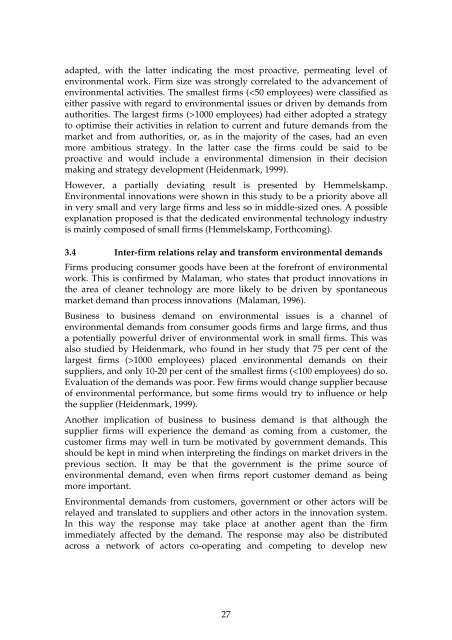Drivers of environmental innovation - Vinnova
Drivers of environmental innovation - Vinnova
Drivers of environmental innovation - Vinnova
You also want an ePaper? Increase the reach of your titles
YUMPU automatically turns print PDFs into web optimized ePapers that Google loves.
adapted, with the latter indicating the most proactive, permeating level <strong>of</strong><br />
<strong>environmental</strong> work. Firm size was strongly correlated to the advancement <strong>of</strong><br />
<strong>environmental</strong> activities. The smallest firms (1000 employees) had either adopted a strategy<br />
to optimise their activities in relation to current and future demands from the<br />
market and from authorities, or, as in the majority <strong>of</strong> the cases, had an even<br />
more ambitious strategy. In the latter case the firms could be said to be<br />
proactive and would include a <strong>environmental</strong> dimension in their decision<br />
making and strategy development (Heidenmark, 1999).<br />
However, a partially deviating result is presented by Hemmelskamp.<br />
Environmental <strong>innovation</strong>s were shown in this study to be a priority above all<br />
in very small and very large firms and less so in middle-sized ones. A possible<br />
explanation proposed is that the dedicated <strong>environmental</strong> technology industry<br />
is mainly composed <strong>of</strong> small firms (Hemmelskamp, Forthcoming).<br />
3.4 Inter-firm relations relay and transform <strong>environmental</strong> demands<br />
Firms producing consumer goods have been at the forefront <strong>of</strong> <strong>environmental</strong><br />
work. This is confirmed by Malaman, who states that product <strong>innovation</strong>s in<br />
the area <strong>of</strong> cleaner technology are more likely to be driven by spontaneous<br />
market demand than process <strong>innovation</strong>s (Malaman, 1996).<br />
Business to business demand on <strong>environmental</strong> issues is a channel <strong>of</strong><br />
<strong>environmental</strong> demands from consumer goods firms and large firms, and thus<br />
a potentially powerful driver <strong>of</strong> <strong>environmental</strong> work in small firms. This was<br />
also studied by Heidenmark, who found in her study that 75 per cent <strong>of</strong> the<br />
largest firms (>1000 employees) placed <strong>environmental</strong> demands on their<br />
suppliers, and only 10-20 per cent <strong>of</strong> the smallest firms (

















